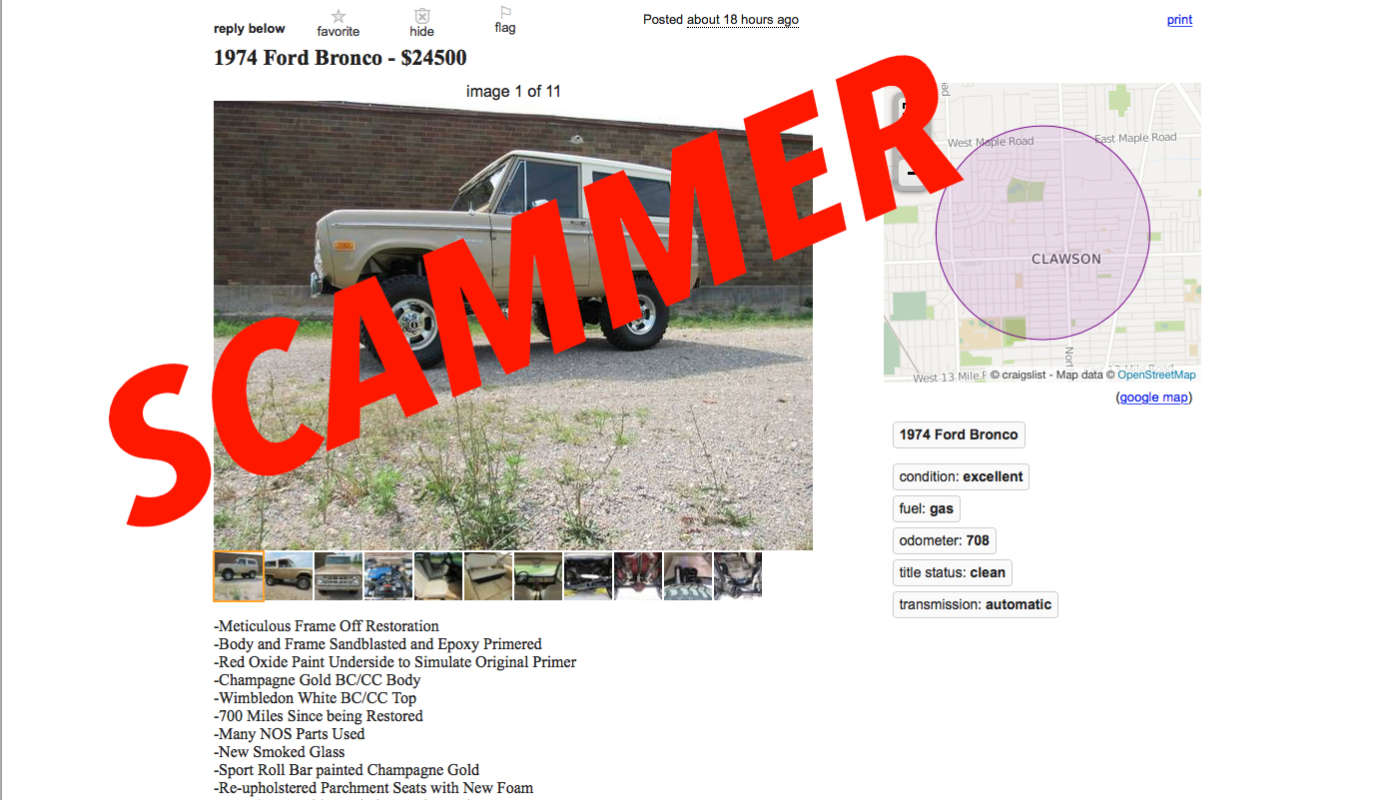
To spot a Craigslist Scammer
By Dean Larson
Whether your Craigslist addiction is severe or recreational, we’ve all come across deals that seem too good to be true. Sure, it’s still possible to get a good buy these days, but all too often, it’s a crafty low-life in some other country looking to misappropriate your funds. What seems to be “grandma’s grocery-getter ’69 Camaro,” can quickly turn into “please mail in $5,000 in Amazon gift cards and I’ll ship the car.”
Spotting a Craigslist scammer was pretty easy a few years back, as the ads almost always consisted of a couple low-resolution photos of a mint-condition vehicle, accompanied by a few generic statements with spelling and grammar errors throughout. “Runs great, dealer maintained, vehicle is in good condition,” etc, etc. And of course, you’d get some ridiculous email address as the only way to contact the owner, and the price was almost always $1,800.
But the scammers have gotten a bit more crafty these days, and they’ve up’d the ante in an effort to swipe your gift cards, money orders and various cryptocurrencies. If you’ve never looked at it, Craigslist’s “avoiding scams & fraud” section (found along the right hand side of your city’s home page) is a great place to start. There you’ll find all sorts of basic info, like “don’t purchase without seeing in person" and "never wire funds or accept cashier’s checks.” All important stuff, but as self-proclaimed professional Craigslisters, we’ve got a couple extra-strategies to share.
We’ll start with some obvious things, but by the time we get to our section on reverse image searching, I’m sure you’ll have learned something. And stick around for the conclusion, where we use these points to debunk a real Craigslist scam ad.
1. If it looks too good to be true…
The low price made you click, understandably so, but in a world where almost everyone knows someone who can use the internet, be wary of something that’s too good to be true. If the item isn’t defective in any way, you should immediately check out a few basic parts of the listing.
Is there a contact name, and a location listed that makes sense? Also, most importantly, is there a phone number, or just an email address with a wacky domain? It’s important to note whether the seller’s contact info was posted in the "reply" box, or in the body of the ad. If it’s posted in the ad body, and it isn’t a phone number where you can reach someone for a call, it’s likely a scam. You should also be suspicious if you find the vehicle posted in multiple cities, especially when they’re not nearby. If the ad says "shipping included," you should also be weary, as shipping is never included. And a scammer is always looking for ways to get you to pay for something you haven't seen in person.
Another step is to check the photos with a critical eye. It seems obvious, but make sure it’s the same vehicle across all the photos. Next, do the surroundings in the photo match the geographic location? Are palm trees visible near a car that's supposedly in Ohio, or mountains Florida? Also, if you can see the license plate, is the car licensed in the state where it’s listed? In addition, we still find that most scam ads to have low-resolution photos, but poor camera work is hardly limited to scams alone.
In summary, you just want to use all the clues possible to make sure that the description of the vehicle matches what you’re seeing.
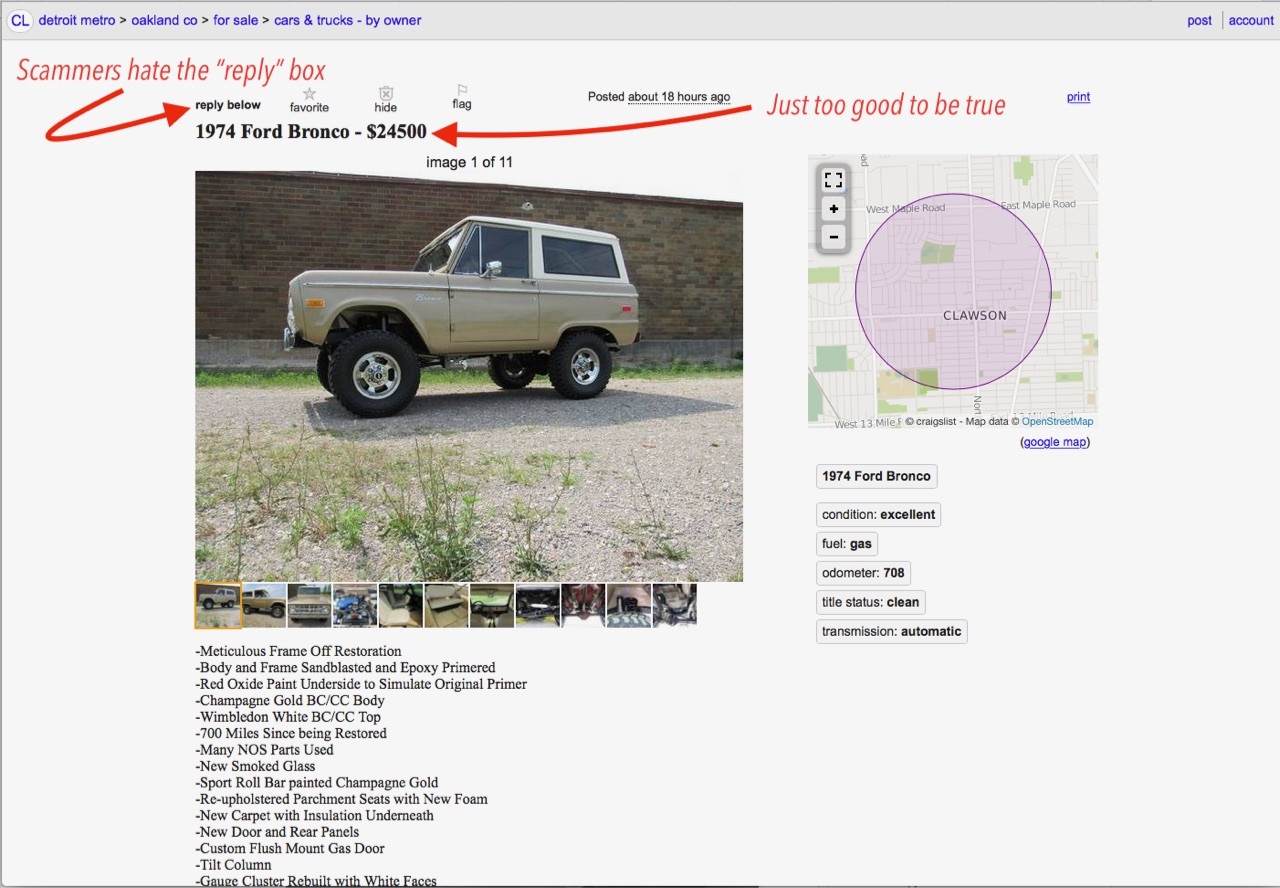
2. Communication breakdown…
Most serious sellers will take a phone call, and this is one of the easiest ways to catch a scammer. Just because the seller needs to communicate by text or email, doesn’t make them a scammer, as sometimes it’s just more convenient. But chalk it up as a red flag if you can’t before moving forward.
On the flip side, a scammer will likely refuse to take a phone call under any circumstances. Since they don’t actually know the vehicle, they’ll want to use text or email, or claim to be working on the seller’s behalf. They won’t have any additional information for you, and won’t be able to answer any advanced inquires. They’ll likely bypass any questions you have and may even supply information that doesn’t match their ad.
In addition, it may take them longer that you’d expect to respond (as this person presumably does other things to make money) and they’ll likely have some sort of extraneous circumstances surrounding the sale. Maybe they’re currently out of the country for work, or are deployed. It’s very unfortunate, but many scammers claim to be enlisted in the military, which is why you need to wire money to one place, while the car comes from somewhere else.
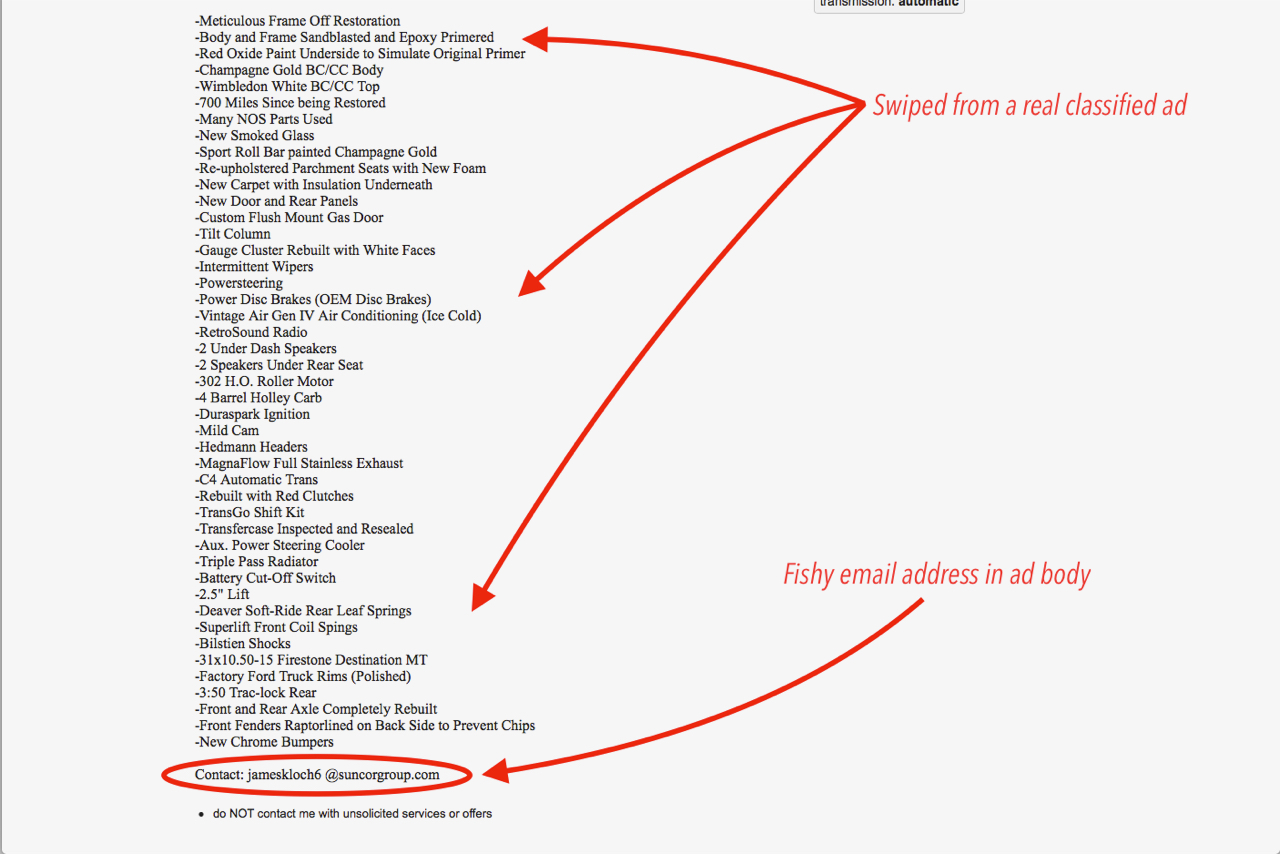
3. Pudding proof...
You know the analogy, and the proof in this case is the physical item. Between a phone call and dealing with the seller face to face, you can avoid 99 percent of scams. So do things the old fashioned way. Go see the car in person, just be sure to bring a friend along if possible.
4. Brass tax...
For the scammer to get their way, they have to trick you into paying for an item that they don’t own (or paying for an item with fake money on the flip side). So for one, don’t pay for something you’re not going to leave with. Again, deal with cash, face to face, and you’re more likely to be safe.
This is also the point where the money wires, cashiers checks, gift cards and cryptocurrencies come into effect. I’m not expert on crypto, so you’re on your own there, but it’s clear to me that gift cards were designed to be gift, not an easily convertible currency. And while it sounds ridiculous, gift cards are in chapter one of the scammer handbook. It’s also important to remember that a bad check or a cancelled check can leave you without a title and your vehicle.
As a total aside, I’ll share with you a few circumstances where I have sold vehicles to buyers who paid with a check. In two instances, I retained the vehicle and the title until my bank verified that the funds became available in my account, and then the buyers returned to collect the title and vehicle. This can take a couple business days, so this is never a good move for a buyer.
In the third instance, I sold a pickup to a buyer who paid with a cashier’s check. But before you cry foul, let me establish that I knew the individual and made contact with the bank to be sure everything was legit. In a perfect world, I wouldn’t advise you to ever take a check for a vehicle, but if you’re going to do it, be safe. Cashier’s checks can be faked!
5. Google knows all…
So up until this point, we’ve covered some fairly basic stuff, but here’s where it gets a bit more interesting. Since the scammer doesn’t own the vehicle, they have to get the images and some details somewhere. Because, yeah, these days the scammers have gotten much better about including very detailed information in their ads. But by using a tool called “reverse image searching,” you can find other instances of the seller’s photos online. Here’s how it works.
Most often, I’m on a desktop, and I’ll drag and drop one of the photos from the ad on to my desktop, or you can save it any other way. Then, I’ll simply open my web browser (I use Chrome) and head over to Google images. You can then drag and drop the image into the search bar, or upload it by selecting the camera icon. The video below describes in more detail how to use this feature, as well as how to use it on a mobile device.
For our purposes, this feature will find other instances of the photos online, such as a listing on a different website, or maybe even posts in a forum. If the additional sources don’t match the information you’re seeing in the Craigslist ad, or if they just seemed like a convenient place to steal images from, you’re likely looking at a scam.
6. How about an example…
So that’s all fine and good, but how about we take a look at a real ad and I’ll show you the process, and even teach you about Craigslist compliers along the way.
Last week, a friend sent me this classified ad from the Detroit Metro Craigslist featuring a nicely restored Bronco for $24,500. We knew the price was a big red flag, as Broncos restored to this level are getting more than twice that today, but the ad was full of information and had decent photos. But check out the contact info; listed “jameskloch6 @suncorgroup.com,” with no phone number — sketchy, second red flag.
Without even reaching out to this “James Kloch6,” I was pretty sure I could find strike three with an image search. A quick drag and drop of the featured photo into Google images, and I saw several instances of the same photos on strange sites like davidsclassiccars.com and mfpclassiccars.com.
Now these sites are just compilers, on which I won’t claim to be an expert, but it seems like they amass photos and descriptions from classified ads hoping that you’ll use their contact forms or advertise with them. They may even be scams themselves, so I wouldn’t go clicking around too much on these.
On davidsclassiccars.com, I found the listing for the Bronco to be almost identical, except a note advising interested parties to contact “Kelly” with any other questions, with a telephone number listed — not the alleged James Kloch6!
I then entered the phone number into Google, eventually arriving at the Facebook page for a shop called Z-Tech Customz LLC, the group actually selling this Bronco. A few scrolls on their page and I found the photos (in high-res) and the full description with an asking price of $72,500 — the smoking gun if you will.
Now that was a lot of ground to cover, but it’s a revealing look at how scammers put together their ads and I hope you picked up a few extra tools along the way. And sure, inevitably some of you will say “of course that Bronco was too good to be true,” but what if it wasn’t? Nothing ventured, nothing gained!
By the way, I did notify Z-Tech that their Bronco was used in a scammer’s ad, which has since been flagged for removal.

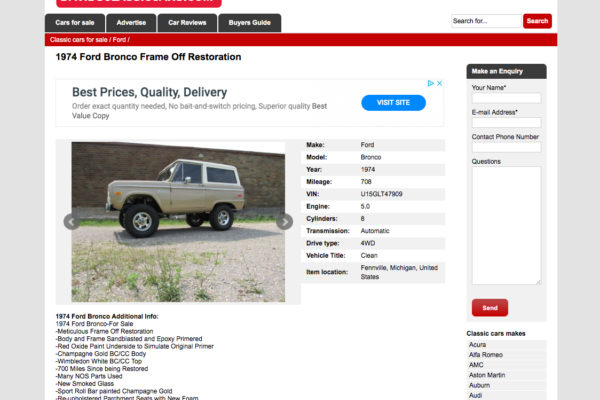
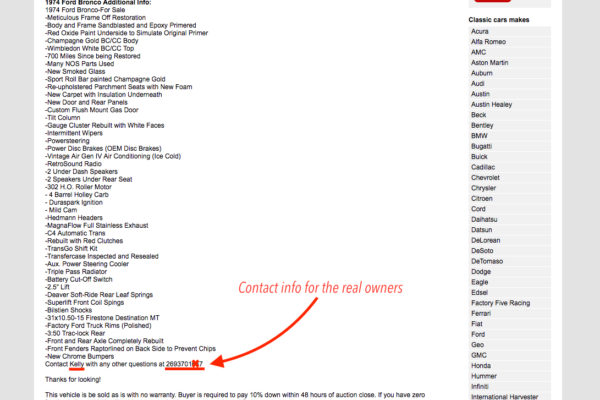
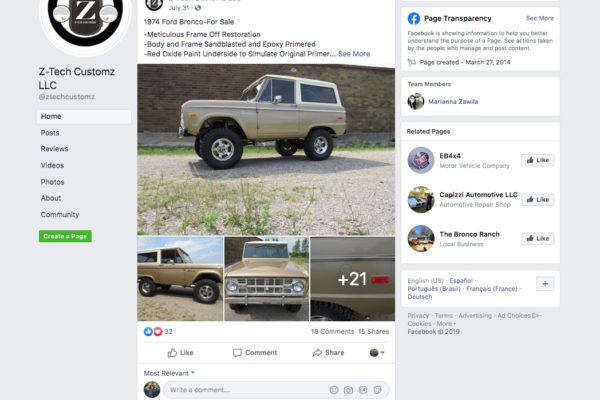
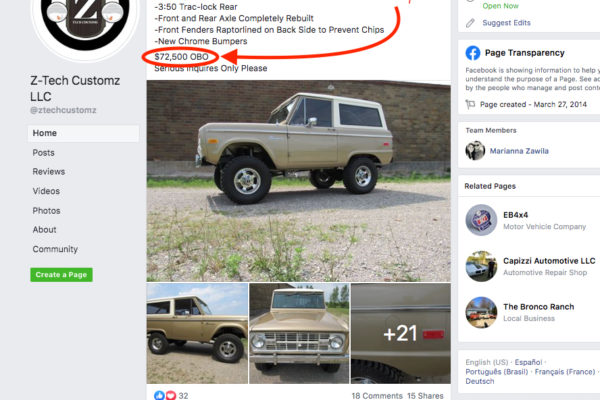

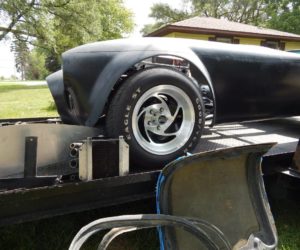


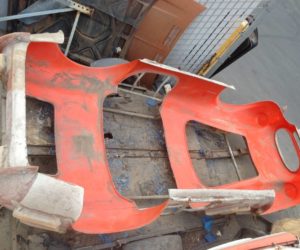





Comments for: To spot a Craigslist Scammer
comments powered by Disqus